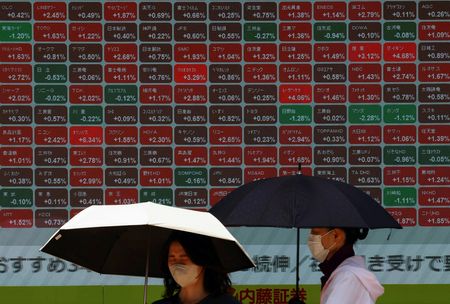By Caroline Valetkevitch
NEW YORK (Reuters) -Major stock indexes extended sharp declines on Friday, with the Nasdaq on track for its biggest weekly percentage decline since March as investors worried about the sustainability of a rally in artificial intelligence shares, while U.S. Treasury yields edged lower again.
Chip and other tech-related stocks have been some of the biggest losers, and an index of semiconductors was down 4.5% on Friday.
The Nasdaq is down more than 4% for the week and on track for its biggest weekly percentage drop since late March. In April, U.S. President Donald Trump announced his sweeping tariffs. The Nasdaq has gained more than 50% since then.
“We’re seeing this AI selloff continue after the comments we had… about China winning the AI race. You’re seeing a recalibration of multiples in the space, so that’s where the bulk of the weakness is,” said Michael O’Rourke, chief market strategist at JonesTrading in Stamford, Connecticut.
“You could also take it as profit-taking. It’s been a very nice run for stocks this year, especially in that group,” O’Rourke said.
The Financial Times reported earlier this week that Nvidia CEO Jensen Huang has warned that China will beat the U.S. in the AI race.
Optimism around artificial intelligence has pushed markets to all-time highs this year.
Bitcoin is also down for the week.
The Dow Jones Industrial Average fell 345.04 points, or 0.74%, to 46,567.26, the S&P 500 fell 75.65 points, or 1.13%, to 6,644.67 and the Nasdaq Composite fell 435.84 points, or 1.89%, to 22,618.15.
MSCI’s gauge of stocks across the globe fell 9.31 points, or 0.94%, to 982.69.The pan-European STOXX 600 index fell 0.55%.
Earlier, China’s blue-chip CSI300 Index and the Shanghai Composite Index both finished 0.3% lower on Friday. Weaker-than-expected China trade data also showed how hard Trump’s tariffs have hit.
China’s exports shrank 1.1% in October, the worst performance since February, data showed, chilling Asian markets with a stark reminder of the manufacturing juggernaut’s reliance on American consumers.
U.S. Treasury yields edged lower again and investors looked ahead to a busy week of government debt auctions.
The yield on benchmark U.S. 10-year notes fell 2.4 basis points to 4.069%, from 4.093% late on Thursday.
The U.S. dollar was set to end the week roughly unchanged.
The greenback had mostly firmed since last week when Federal Reserve Chair Jerome Powell acknowledged the risky nature of further easing moves.
The U.S. shutdown has prevented the release of key economic data. Still, data signals from surveys suggest a resilience that could support the case for not cutting rates at the Federal Reserve’s December meeting.
On the day, the dollar index, which measures the greenback against a basket of currencies including the yen and the euro, fell 0.19% to 99.50, with the euro up 0.23% at $1.1574.Against the Japanese yen, the dollar strengthened 0.03% to 153.11.
U.S. crude rose 0.62% to $59.80 a barrel and Brent rose to $63.68 per barrel, up 0.47% on the day.
(Additional reporting by Lawrence White in London and Dhara Ranasinghe; Editing by Louise Heavens and Deepa Babington)










